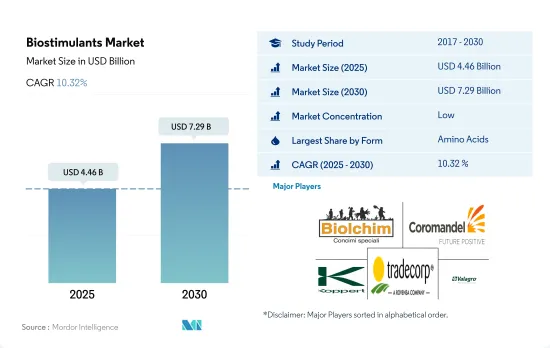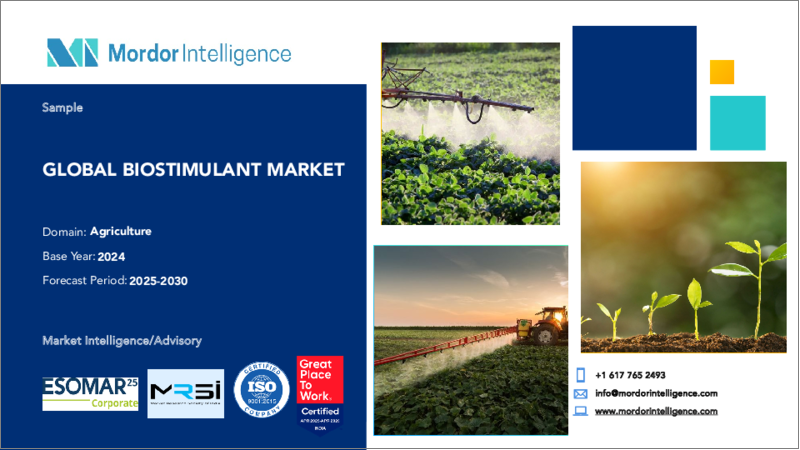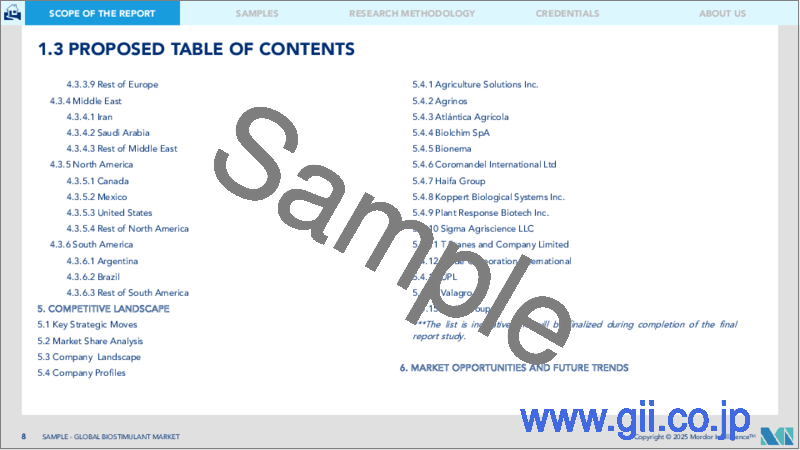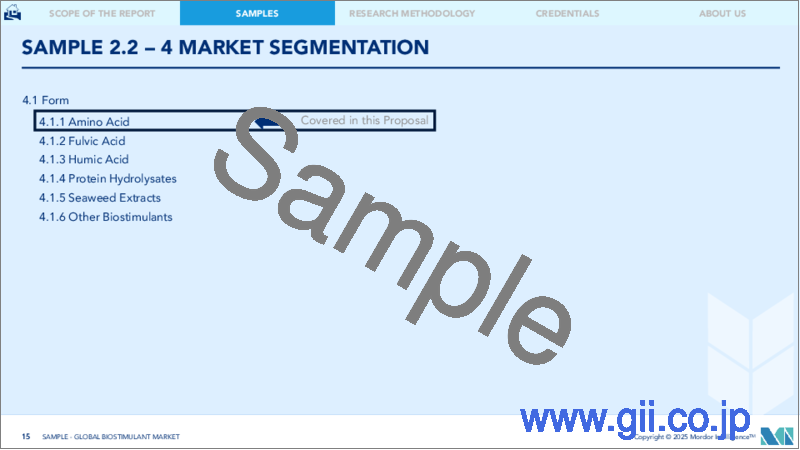|
|
市場調査レポート
商品コード
1685909
バイオスティミュラント:市場シェア分析、産業動向・統計、成長予測(2025年~2030年)Biostimulants - Market Share Analysis, Industry Trends & Statistics, Growth Forecasts (2025 - 2030) |
||||||
カスタマイズ可能
適宜更新あり
|
|||||||
| バイオスティミュラント:市場シェア分析、産業動向・統計、成長予測(2025年~2030年) |
|
出版日: 2025年03月18日
発行: Mordor Intelligence
ページ情報: 英文 320 Pages
納期: 2~3営業日
|
全表示
- 概要
- 目次
バイオスティミュラントの市場規模は2025年に44億6,000万米ドルと推定され、2030年には72億9,000万米ドルに達すると予測され、予測期間中(2025-2030年)のCAGRは10.32%で成長する見込みです。

- 農業におけるバイオスティミュラントの使用は近年勢いを増しており、作物の成長と収量に対するバイオスティミュラント製品の利点に対する農家の意識が高まっています。バイオ刺激剤は、植物の成長を促進し、栄養の取り込み、ストレス耐性、健康全般を改善する天然または合成物質です。
- アミノ酸は、世界で最も消費されているバイオスティミュラントとして浮上し、2022年の市場シェアは32.0%でした。この高いシェアは主に、欧州諸国の冬小麦作物で種子収量や穂当たりの穀物数を増加させるなど、アミノ酸を散布すると作物に好影響を与えることによるものです。バイオスティミュラントの消費は連作作物で最も多く、2022年の市場シェアの74.6%を占め、園芸作物、換金作物がこれに続いた。
- バイオスティミュラント分野は欧州が圧倒的で、2022年の市場シェアは40.6%、次いで北米、アジア太平洋でした。この高いシェアは、同地域の農家の意識が高いことと、政府が2030年までに農地の25.0%を有機農業にするという目標を掲げて有機農業を推進していることによる。
- バイオスティミュラント分野は、有機製品に対する需要の高まりと有機作物の栽培面積の増加に牽引され、2023年から2029年にかけてCAGR 10.1%を記録すると予想されます。
- バイオスティミュラントは、化学肥料や農薬の使用を減らすために農業業界で人気を博しています。健全な速度で成長している有機食品産業も、バイオスティミュラント市場の成長を支える大きな原動力となっています。
- 欧州は世界のバイオスティミュラントの最大市場であり、2022年には13億米ドルと評価され、市場金額の40.6%を占める。欧州委員会は、加盟国がそれぞれの農地の25%を有機農業に移行させるという目標を掲げており、バイオベース経済のためのスマートな成長と革新という欧州の重要な優先課題を強化しています。バイオスティミュラントは、そのための重要な原料です。ドイツは、バイオスティミュラントの効果を高めるための研究開発に投資することで、こうした目標の達成に主導的な役割を果たしています。
- 北米は世界のバイオスティミュラント市場において第2位の市場であり、2022年の市場規模は8億4,020万米ドルです。この地域の国々は有機農業を増やす政策を導入しており、米国では2022年に3億米ドルを投資するUSDAの有機農業移行イニシアティブ(Organic Transition Initiative)があります。このイニシアチブは、農家への資金援助を行い、バイオスティミュラントの有益な影響についての認識を高めるなど、農家間の指導を奨励することを目的としています。
- アジア太平洋地域は、バイオスティミュラント市場で第3位の地位を占めており、世界最大の肥料消費国である中国は、すでに作物生産に有機投入物を使用しています。同様に、南米とアフリカも、生産者の意識の高まりにより、バイオ刺激剤市場の変動を目の当たりにしています。化学投入物の使用量削減と世界の有機栽培面積の増加は、予測期間中にCAGR 10.1%でバイオ刺激剤市場を牽引すると予測されます。
世界のバイオスティミュラント市場動向
意識の高まりと政府の取り組みが、北米と欧州の有機生産を促進しています。
- 有機農業は持続可能な食糧システムに大きく貢献するものとして台頭し、世界187カ国で実践されています。2021年現在、世界の有機農地は7,230万ヘクタールで、2018年から2021年にかけて全地域で平均2.9%増加します。このうち、2021年の有機耕地面積は1,440万ヘクタールで、有機農地全体の19.9%を占める。有機農業の最強市場は北米と欧州で、2022年の世界の有機耕地面積の41.0%を占める。欧州の有機耕地は2022年には650万ヘクタールで、有機耕地全体の44.1%に相当します。北米と欧州で有機栽培されている最も重要な作物は、リンゴ、イチゴ、穀物、オリーブなどです。
- アジア太平洋地域の新興諸国も有機農業運動に参加し、国内需要を満たす新鮮な有機農産物の生産と供給で自給自足しつつあります。アジア太平洋地域では有機農業の増加傾向が見られ、2017年から2022年にかけて有機耕地面積は18.8%増加しました。この地域の政府による主要な取り組みも、有機農業を後押しする上で重要な役割を果たしています。例えば、日本の2021年農業・経営基本計画は、2030年までに有機農業者数と有機耕地数を3倍に増やすことを目指しています。
- 有機農業は世界的に人気が高まっており、持続可能な食糧システムを実現するためにさまざまな国が有機農業を採用しています。有機農業の成長の原動力となっているのは、土壌の健全性を促進し、環境への影響を低減し、より健康的な食品を生産するといった有機農業の利点に対する意識の高まりです。
有機食品の1人当たり支出は主に米国とドイツで観察されるが、これはより健康的で持続可能な食品に対する消費者の需要に起因します。
- 有機食品市場は過去10年間に著しい成長を遂げ、世界の売上高は2012年の708億米ドルから2020年には1,206億米ドルに達します。有機食品への動向は、より健康的で持続可能な食品の選択肢を求める消費者需要の高まりや、従来型農業が環境に与える影響に対する意識の高まりなど、いくつかの要因に後押しされています。
- オーガニック・トレード協会が実施した調査によると、2021年のオーガニック果物・野菜の売上は同年約4.5%増加し、オーガニック売上全体の15%を占めました。有機製品への平均支出額では現在北米が市場を独占しており、米国の1人当たり支出額は2021年に186.7米ドルに達し、北米諸国の中で最も高いです。欧州もオーガニック市場で大きな成長が見込まれており、同年の1人当たり支出額が最も高いのはドイツで75.6米ドルです。
- 有機食品市場は、可処分所得の高い先進諸国が依然として支配的であるが、新興諸国でも成長が見込まれます。例えばアジア太平洋地域では、労働者階級の増加が市場拡大に寄与すると思われます。オーガニック製品の入手可能性が高まるにつれて、価格も手頃になります。
- オーガニック食品市場は世界的に大きな成長を遂げており、予測期間中も継続すると予想されます。
バイオスティミュラント産業の概要
バイオスティミュラント市場は細分化されており、上位5社で11.95%を占めています。この市場の主要企業は以下の通りです。 Biolchim SpA, Coromandel International Ltd, Koppert Biological Systems Inc., Trade Corporation International and Valagro(sorted alphabetically).
その他の特典
- エクセル形式の市場予測(ME)シート
- 3ヶ月のアナリストサポート
目次
第1章 エグゼクティブサマリーと主な調査結果
第2章 レポートのオファー
第3章 イントロダクション
- 調査の前提条件と市場定義
- 調査範囲
- 調査手法
第4章 主要産業動向
- 有機栽培面積
- 一人当たりのオーガニック製品への支出
- 規制の枠組み
- アルゼンチン
- オーストラリア
- ブラジル
- カナダ
- 中国
- エジプト
- フランス
- ドイツ
- インド
- インドネシア
- イタリア
- 日本
- メキシコ
- オランダ
- ナイジェリア
- フィリピン
- ロシア
- 南アフリカ
- スペイン
- タイ
- トルコ
- 英国
- 米国
- ベトナム
- バリューチェーンと流通チャネル分析
第5章 市場セグメンテーション
- 形態
- アミノ酸
- フルボ酸
- フミン酸
- タンパク質加水分解物
- 海藻エキス
- その他のバイオスティミュラント
- 作物タイプ
- 換金作物
- 園芸作物
- 畑作物
- 地域
- アフリカ
- 国別
- エジプト
- ナイジェリア
- 南アフリカ
- その他のアフリカ
- アジア太平洋
- 国別
- オーストラリア
- 中国
- インド
- インドネシア
- 日本
- フィリピン
- タイ
- ベトナム
- その他アジア太平洋地域
- 欧州
- 国別
- フランス
- ドイツ
- イタリア
- オランダ
- ロシア
- スペイン
- トルコ
- 英国
- その他欧州
- 中東
- 国別
- イラン
- サウジアラビア
- その他中東
- 北米
- 国別
- カナダ
- メキシコ
- 米国
- その他北米地域
- 南米
- 国別
- アルゼンチン
- ブラジル
- その他南米
- アフリカ
第6章 競合情勢
- 主要な戦略動向
- 市場シェア分析
- 企業情勢
- 企業プロファイル.
- Agriculture Solutions Inc.
- Agrinos
- Atlantica Agricola
- Biolchim SpA
- Bionema
- Coromandel International Ltd
- Haifa Group
- Koppert Biological Systems Inc.
- Plant Response Biotech Inc.
- Sigma Agriscience LLC
- T Stanes and Company Limited
- Trade Corporation International
- UPL
- Valagro
- Vittia Group
第7章 CEOへの主な戦略的質問
第8章 付録
- 世界概要
- 概要
- ファイブフォース分析フレームワーク
- 世界のバリューチェーン分析
- 市場力学(DROs)
- 情報源と参考文献
- 図表一覧
- 主要洞察
- データパック
- 用語集
The Biostimulants Market size is estimated at 4.46 billion USD in 2025, and is expected to reach 7.29 billion USD by 2030, growing at a CAGR of 10.32% during the forecast period (2025-2030).

- The use of biostimulants in agriculture has gained momentum in recent years, with increasing awareness among farmers about the benefits of these products on crop growth and yield. Biostimulants are natural or synthetic substances that enhance plant growth and improve nutrient uptake, stress tolerance, and overall health.
- Amino acids emerged as the most consumed biostimulants globally, with a market share of 32.0% in 2022. This high share was primarily due to the positive effects of amino acids on crops when applied, such as increasing seed yield and grain numbers per ear in winter wheat crops in European countries. The consumption of biostimulants was the highest in row crops, which accounted for 74.6% of the market share in 2022, followed by horticultural crops and cash crops.
- Europe dominated the biostimulants segment, with a market share of 40.6% in 2022, followed by North America and Asia-Pacific. This high share was due to the high awareness among farmers in the region and the government's promotion of organic agriculture, with a target of 25.0% of agricultural land to be organic by 2030.
- The biostimulants segment is expected to record a CAGR of 10.1% between 2023 and 2029, driven by the increasing demand for organic products and the growing area under the cultivation of organic crops.
- Biostimulants have gained popularity in the agricultural industry to reduce the use of chemical fertilizers and pesticides. The organic food industry, which is growing at a healthy rate, is another major driving force behind the growth of the biostimulant market.
- Europe is the largest market for global biostimulants, accounting for 40.6% of the market value, valued at USD 1.3 billion, in 2022. The European Commission has set a target for member countries to bring 25% of their respective agricultural land under organic farming, reinforcing Europe's key priorities for smart growth and innovation for the bio-based economy. Biostimulants represent a critical ingredient for the same. Germany plays a lead role in achieving these objectives by investing in R&D to enhance the effectiveness of biostimulants.
- North America is the second-largest market for global biostimulants, with a market value of USD 840.2 million in 2022. Countries in the region are introducing policies to increase organic farming, such as the USDA's Organic Transition Initiative in the United States, with an investment of USD 300 million in 2022. This initiative aims to provide financial assistance to farmers and encourage farmer-to-farmer mentoring, including creating awareness of the beneficial impacts of biostimulants.
- The Asia-Pacific region holds the third-largest position in the biostimulants market, with China, the world's largest fertilizer consumer, already using organic inputs for crop production. Similarly, South America and Africa have also witnessed a flux in the biostimulants market due to increased awareness among growers. The reduced usage of chemical inputs and increasing global organic area are projected to drive the biostimulants market at a CAGR of 10.1% during the forecast period.
Global Biostimulants Market Trends
The increasing awareness and Government initiatives is driving the organic production in North America and Europe.
- Organic agriculture has emerged as a significant contributor to sustainable food systems, with 187 countries practicing it globally. As of 2021, there are 72.3 million hectares of organic agricultural land globally, with an average increase of 2.9% across all regions from 2018 to 2021. Among these, organic arable land accounted for 14.4 million hectares in 2021, representing 19.9% of the total organic agricultural land. The strongest markets for organic farming are in North America and Europe, accounting for 41.0% of the global organic arable land in 2022. The total organic arable land in Europe was 6.5 million hectares in 2022, equivalent to 44.1% of the overall organic arable agricultural area. The most significant crops grown organically in North America and Europe are apples, strawberries, cereals, and olives, among others.
- Developing countries in the Asia-Pacific region are also joining the organic agriculture movement and becoming self-sufficient in producing and providing fresh organic produce to meet domestic demand. The Asia-Pacific region observed an increasing trend in organic farming, with an 18.8% increase in organic arable land from 2017 to 2022. The major initiatives by governments in the region have also played a vital role in boosting organic farming. For example, Japan's Basic Plan for Agriculture and Management in 2021 aims to triple the number of organic farmers and organic lands by 2030.
- Organic agriculture is becoming increasingly popular globally, with various countries adopting it to achieve sustainable food systems. The growth in organic agriculture is driven by the increasing awareness about the benefits of organic farming, such as promoting soil health, reducing environmental impacts, and producing healthier food.
Per capita spending of organic food majorly observed in United States and Germany, attributed to the consumer demand for healthier and sustainable food
- The organic food market has experienced significant growth over the past decade, with global sales reaching USD 120.6 billion in 2020, up from USD 70.8 billion in 2012. The trend toward organic food is driven by several factors, including increasing consumer demand for healthier, more sustainable food options and growing awareness about the environmental impact of conventional agriculture.
- According to a survey conducted by the Organic Trade Association, in 2021, sales of organic fruits and vegetables increased by around 4.5% that year, accounting for 15% of the overall organic sales. North America currently dominates the market in terms of average spending on organic products, with per capita spending in the United States reaching USD 186.7 in 2021, the highest among North American countries. Europe is also expected to experience significant growth in the organic market, with Germany accounting for the highest per capita spending of USD 75.6 during the same year.
- While the organic food market is still dominated by developed countries with high levels of disposable income, it is also expected to grow in developing nations. For example, in the Asia-Pacific region, the increase in the number of working-class people is likely to contribute to market expansion. As the availability of organic products increases, prices become more affordable.
- The organic food market is experiencing significant growth globally and is expected to continue during the forecast period.
Biostimulants Industry Overview
The Biostimulants Market is fragmented, with the top five companies occupying 11.95%. The major players in this market are Biolchim SpA, Coromandel International Ltd, Koppert Biological Systems Inc., Trade Corporation International and Valagro (sorted alphabetically).
Additional Benefits:
- The market estimate (ME) sheet in Excel format
- 3 months of analyst support
TABLE OF CONTENTS
1 EXECUTIVE SUMMARY & KEY FINDINGS
2 REPORT OFFERS
3 INTRODUCTION
- 3.1 Study Assumptions & Market Definition
- 3.2 Scope of the Study
- 3.3 Research Methodology
4 KEY INDUSTRY TRENDS
- 4.1 Area Under Organic Cultivation
- 4.2 Per Capita Spending On Organic Products
- 4.3 Regulatory Framework
- 4.3.1 Argentina
- 4.3.2 Australia
- 4.3.3 Brazil
- 4.3.4 Canada
- 4.3.5 China
- 4.3.6 Egypt
- 4.3.7 France
- 4.3.8 Germany
- 4.3.9 India
- 4.3.10 Indonesia
- 4.3.11 Italy
- 4.3.12 Japan
- 4.3.13 Mexico
- 4.3.14 Netherlands
- 4.3.15 Nigeria
- 4.3.16 Philippines
- 4.3.17 Russia
- 4.3.18 South Africa
- 4.3.19 Spain
- 4.3.20 Thailand
- 4.3.21 Turkey
- 4.3.22 United Kingdom
- 4.3.23 United States
- 4.3.24 Vietnam
- 4.4 Value Chain & Distribution Channel Analysis
5 MARKET SEGMENTATION (includes market size in Value in USD and Volume, Forecasts up to 2030 and analysis of growth prospects)
- 5.1 Form
- 5.1.1 Amino Acids
- 5.1.2 Fulvic Acid
- 5.1.3 Humic Acid
- 5.1.4 Protein Hydrolysates
- 5.1.5 Seaweed Extracts
- 5.1.6 Other Biostimulants
- 5.2 Crop Type
- 5.2.1 Cash Crops
- 5.2.2 Horticultural Crops
- 5.2.3 Row Crops
- 5.3 Region
- 5.3.1 Africa
- 5.3.1.1 By Country
- 5.3.1.1.1 Egypt
- 5.3.1.1.2 Nigeria
- 5.3.1.1.3 South Africa
- 5.3.1.1.4 Rest of Africa
- 5.3.2 Asia-Pacific
- 5.3.2.1 By Country
- 5.3.2.1.1 Australia
- 5.3.2.1.2 China
- 5.3.2.1.3 India
- 5.3.2.1.4 Indonesia
- 5.3.2.1.5 Japan
- 5.3.2.1.6 Philippines
- 5.3.2.1.7 Thailand
- 5.3.2.1.8 Vietnam
- 5.3.2.1.9 Rest of Asia-Pacific
- 5.3.3 Europe
- 5.3.3.1 By Country
- 5.3.3.1.1 France
- 5.3.3.1.2 Germany
- 5.3.3.1.3 Italy
- 5.3.3.1.4 Netherlands
- 5.3.3.1.5 Russia
- 5.3.3.1.6 Spain
- 5.3.3.1.7 Turkey
- 5.3.3.1.8 United Kingdom
- 5.3.3.1.9 Rest of Europe
- 5.3.4 Middle East
- 5.3.4.1 By Country
- 5.3.4.1.1 Iran
- 5.3.4.1.2 Saudi Arabia
- 5.3.4.1.3 Rest of Middle East
- 5.3.5 North America
- 5.3.5.1 By Country
- 5.3.5.1.1 Canada
- 5.3.5.1.2 Mexico
- 5.3.5.1.3 United States
- 5.3.5.1.4 Rest of North America
- 5.3.6 South America
- 5.3.6.1 By Country
- 5.3.6.1.1 Argentina
- 5.3.6.1.2 Brazil
- 5.3.6.1.3 Rest of South America
- 5.3.1 Africa
6 COMPETITIVE LANDSCAPE
- 6.1 Key Strategic Moves
- 6.2 Market Share Analysis
- 6.3 Company Landscape
- 6.4 Company Profiles (includes Global Level Overview, Market Level Overview, Core Business Segments, Financials, Headcount, Key Information, Market Rank, Market Share, Products and Services, and Analysis of Recent Developments).
- 6.4.1 Agriculture Solutions Inc.
- 6.4.2 Agrinos
- 6.4.3 Atlantica Agricola
- 6.4.4 Biolchim SpA
- 6.4.5 Bionema
- 6.4.6 Coromandel International Ltd
- 6.4.7 Haifa Group
- 6.4.8 Koppert Biological Systems Inc.
- 6.4.9 Plant Response Biotech Inc.
- 6.4.10 Sigma Agriscience LLC
- 6.4.11 T Stanes and Company Limited
- 6.4.12 Trade Corporation International
- 6.4.13 UPL
- 6.4.14 Valagro
- 6.4.15 Vittia Group
7 KEY STRATEGIC QUESTIONS FOR AGRICULTURAL BIOLOGICALS CEOS
8 APPENDIX
- 8.1 Global Overview
- 8.1.1 Overview
- 8.1.2 Porter's Five Forces Framework
- 8.1.3 Global Value Chain Analysis
- 8.1.4 Market Dynamics (DROs)
- 8.2 Sources & References
- 8.3 List of Tables & Figures
- 8.4 Primary Insights
- 8.5 Data Pack
- 8.6 Glossary of Terms





